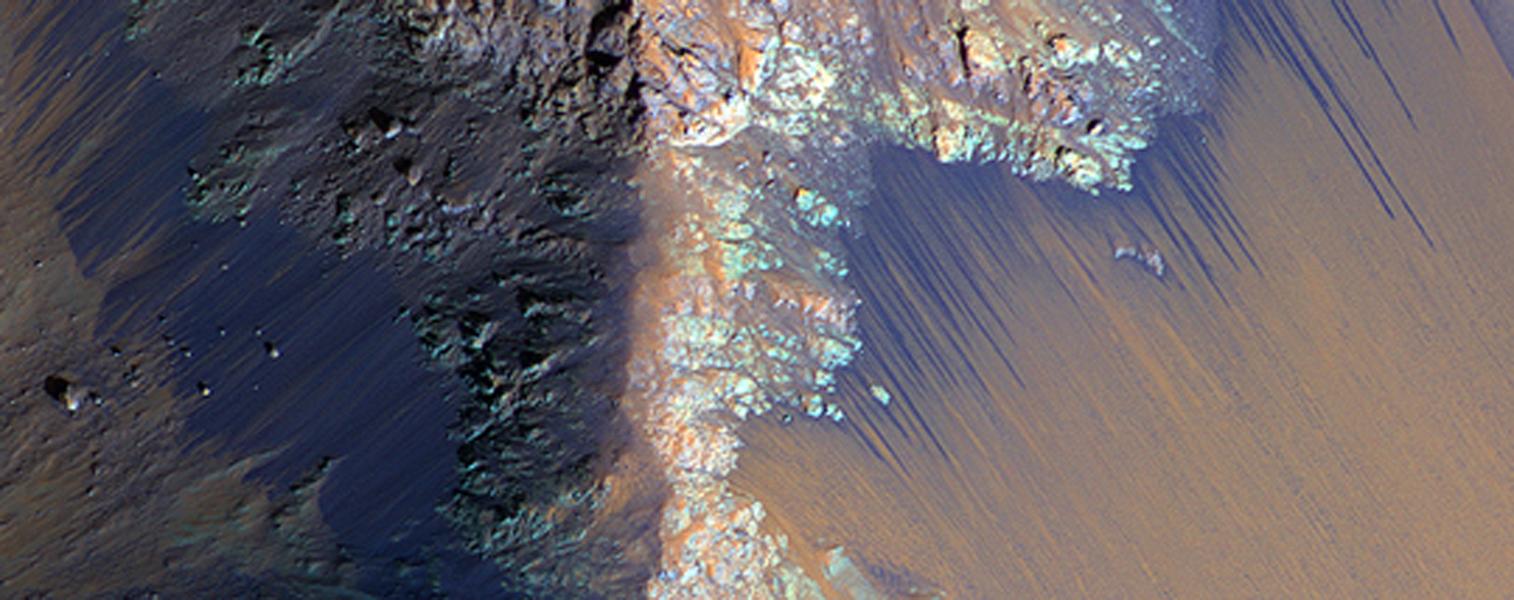New results from Mars orbiters show liquids flowing on the surface of Mars.

Water on Mars? It’s an old story from the Red Planet, and the facts is that landers have frequently found water in the form of ice just below the surface.
But NASA has just announced new results based on high-resolution imagery from NASA’s Mars Reconnaissance Orbiter satellite showing that liquid water also occasionally flows on the surface. This conclusion is based on spectroscopic analysis of dark, seasonal streaks on the sides of craters and other features known as “recurrent slope lineae,” which look like long fingers that appear and lengthen during the martian summers. For years, there’s been argument about what is causing the lineae: Is it really water, or could it be something else – even dry material slowly tumbling down the slopes?
The argument is apparently over. The new results come down heavily in favor of water – highly salty, yes, but liquid water.

These dark, narrow, 100-meter-long streaks called recurring slope lineae flowing downhill on Mars are inferred to have been formed by contemporary flowing water. Recently, planetary scientists detected hydrated salts on these slopes at Horowitz crater, corroborating their original hypothesis that the streaks are indeed formed by liquid water. (Photo: NASA/JPL/University of Arizona)
The source of the water is still unclear, but a favored explanation is that it’s seeping out of underground aquifers – reservoirs of water hulking in the crust of Mars.
That has obvious, and encouraging, implications for any future efforts to send humans to the Red Planet. A simple drilling rig might be all that’s necessary to get to supplies of precious water, not just for drinking but also for rocket fuel.
But another important consequence of this discovery is its effect on how we search for evidence of martian life. Rather than continuing to methodically learn more about the history of the planet in the hope of knowing where to look for remnants of ancient life, this suggests that simply getting a probe to the site of the lineae might offer the chance of finding biology, not from 3 or 4 billion years ago, but still extant microbes in the hidden underground reservoirs of the Red Planet.
The Experts Speak
 The Meaning of NASA's Announcement: More Profound Than You Think
The Meaning of NASA's Announcement: More Profound Than You Think
By Nathalie A. Cabrol, Carl Sagan Director at the SETI Institute
NASA just announced that the Mars Reconnaissance Orbiter data show that recurring slope lineae (RSL) are formed by water flowing at the surface of Mars today. This is big news. No, let me rephrase that: This is huge news … but not necessarily for the reasons emphasized by most headlines.
Here’s why: We have known for years that brines are flowing in gullies every spring and summer. The big news is not really that.
The big news is first about the fact that the RSLs are a scientific mystery that has vexed scientists for years. We can now say, “mystery solved”! And solving that mystery has taken years of not only collecting images and looking for changes. On their own, these would not be enough to close that case. It was also about collecting spectra and mineralogical data, and thinking about converging evidence. It is about the resilience of a team that has used to its best science by testing hypotheses over thousands of observations. Reward after frustration.
 Be Careful When Exploring the Lineae
Be Careful When Exploring the Lineae
By John Rummel, Senior Scientist at the SETI Institute
One of the central goals for Mars exploration is to determine whether or not Mars is the abode of life -- or was in the past. Another is to understand the surface of Mars to ensure that it is, or can be, safe for human exploration. Both of these goals would be harmed, perhaps permanently, by the introduction of Earth organisms into environments on Mars where they could grow and reproduce.
The features known as recurrent slope lineae (RSL) are indicative, at the very least, of processes on Mars that involve fluid flows that we don't understand -- and it may very well be that that fluid is liquid water. To blunder into RSL without cleaning up your rover, first (prior to launch) would be a tragic mistake, and a foolish one. The fact that RSL are on steep slopes where one could very well lose the rover to an unplanned tumble only compounds the problem. Before we study RSL "in depth" we need to be prepared for the unknown, and clean enough to sink into them if they turn out to be soft spots on the slopes of Mars.





